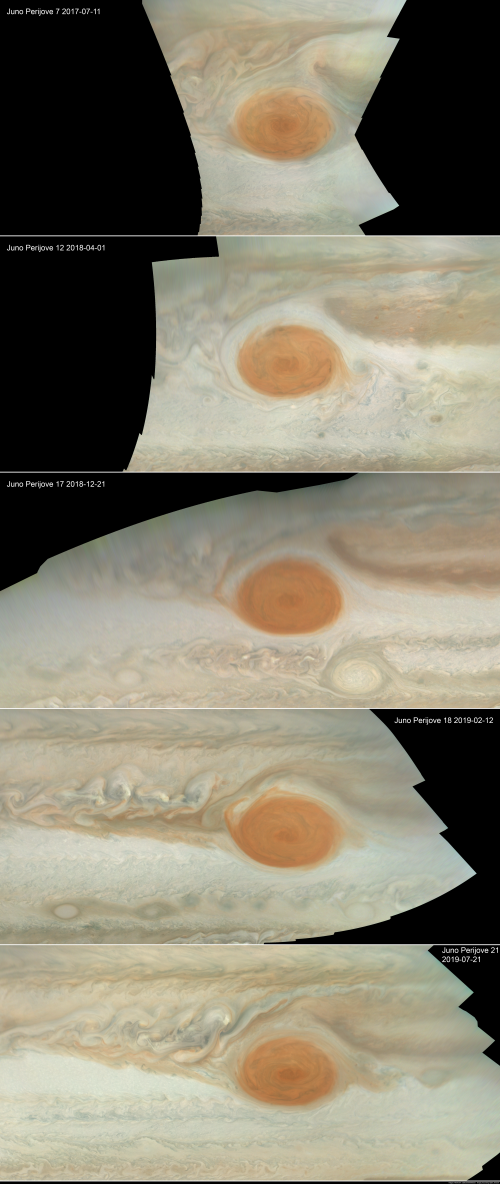Jupiter’s changing Great Red Spot, as seen by Juno
Citizen scientist Björn Jónsson has compiled the montage to the right, reduced to post here, of the five times Jupiter’s Great Red Spot (GRS) was imaged by Juno during its repeated orbital fly-bys.
The mosaics show how the GRS and nearby areas have changed over the course of the Juno mission. The mosaics cover planetographic latitudes 4.7 to 38 degrees south.
The resolution of the source data is highly variable and this can be seen in some of the mosaics. The viewing geometry also varies a lot. Some of the images were obtained almost directly above the GRS (in particular some of the perijove 7 images) whereas other images were obtained at an oblique viewing angle (in particular the perijove 17 images).
These are approximately true color/contrast mosaics but there may be some inaccuracies in areas where the original images were obtained at a highly oblique angle. The contrast is also lower in these areas.
Some of the changes are remarkable, considering the short time involved. For example, note the appearance of the large white storm below the Spot in the third image, taken in December 2018. It wasn’t there in April 2018, and was gone by Feburary 2019. This doesn’t mean it had dissipated. Instead, the storm is in a different band which moves at a different speed than the band that the Spot is in. It has thus simply moved away.
This movement is even more remarkable when we remember that the Great Red Spot is about the width of the Earth.
On Christmas Eve 1968 three Americans became the first humans to visit another world. What they did to celebrate was unexpected and profound, and will be remembered throughout all human history. Genesis: the Story of Apollo 8, Robert Zimmerman's classic history of humanity's first journey to another world, tells that story, and it is now available as both an ebook and an audiobook, both with a foreword by Valerie Anders and a new introduction by Robert Zimmerman.
The print edition can be purchased at Amazon or from any other book seller. If you want an autographed copy the price is $60 for the hardback and $45 for the paperback, plus $8 shipping for each. Go here for purchasing details. The ebook is available everywhere for $5.99 (before discount) at amazon, or direct from my ebook publisher, ebookit. If you buy it from ebookit you don't support the big tech companies and the author gets a bigger cut much sooner.
The audiobook is also available at all these vendors, and is also free with a 30-day trial membership to Audible.
"Not simply about one mission, [Genesis] is also the history of America's quest for the moon... Zimmerman has done a masterful job of tying disparate events together into a solid account of one of America's greatest human triumphs."--San Antonio Express-News
Citizen scientist Björn Jónsson has compiled the montage to the right, reduced to post here, of the five times Jupiter’s Great Red Spot (GRS) was imaged by Juno during its repeated orbital fly-bys.
The mosaics show how the GRS and nearby areas have changed over the course of the Juno mission. The mosaics cover planetographic latitudes 4.7 to 38 degrees south.
The resolution of the source data is highly variable and this can be seen in some of the mosaics. The viewing geometry also varies a lot. Some of the images were obtained almost directly above the GRS (in particular some of the perijove 7 images) whereas other images were obtained at an oblique viewing angle (in particular the perijove 17 images).
These are approximately true color/contrast mosaics but there may be some inaccuracies in areas where the original images were obtained at a highly oblique angle. The contrast is also lower in these areas.
Some of the changes are remarkable, considering the short time involved. For example, note the appearance of the large white storm below the Spot in the third image, taken in December 2018. It wasn’t there in April 2018, and was gone by Feburary 2019. This doesn’t mean it had dissipated. Instead, the storm is in a different band which moves at a different speed than the band that the Spot is in. It has thus simply moved away.
This movement is even more remarkable when we remember that the Great Red Spot is about the width of the Earth.
On Christmas Eve 1968 three Americans became the first humans to visit another world. What they did to celebrate was unexpected and profound, and will be remembered throughout all human history. Genesis: the Story of Apollo 8, Robert Zimmerman's classic history of humanity's first journey to another world, tells that story, and it is now available as both an ebook and an audiobook, both with a foreword by Valerie Anders and a new introduction by Robert Zimmerman.
The print edition can be purchased at Amazon or from any other book seller. If you want an autographed copy the price is $60 for the hardback and $45 for the paperback, plus $8 shipping for each. Go here for purchasing details. The ebook is available everywhere for $5.99 (before discount) at amazon, or direct from my ebook publisher, ebookit. If you buy it from ebookit you don't support the big tech companies and the author gets a bigger cut much sooner.
The audiobook is also available at all these vendors, and is also free with a 30-day trial membership to Audible.
"Not simply about one mission, [Genesis] is also the history of America's quest for the moon... Zimmerman has done a masterful job of tying disparate events together into a solid account of one of America's greatest human triumphs."--San Antonio Express-News


